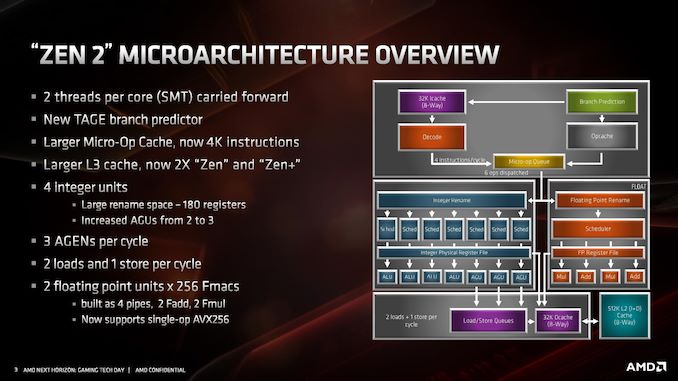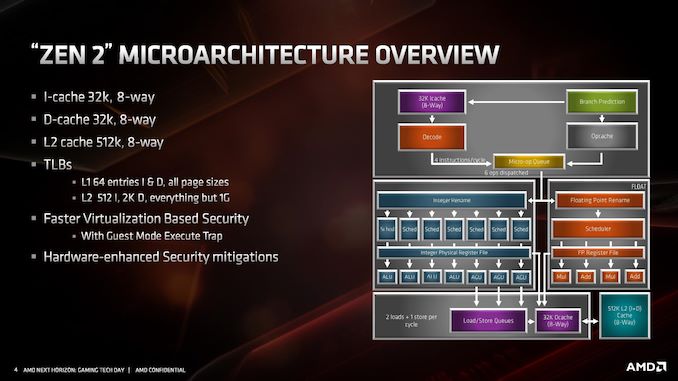AMD Zen 2 Microarchitecture Analysis: Ryzen 3000 and EPYC Rome
by Dr. Ian Cutress on June 10, 2019 7:22 PM EST- Posted in
- CPUs
- AMD
- Ryzen
- EPYC
- Infinity Fabric
- PCIe 4.0
- Zen 2
- Rome
- Ryzen 3000
- Ryzen 3rd Gen
AMD Zen 2 Microarchitecture Overview
The Quick Analysis
At AMD’s Tech Day, on hand was Fellow and Chief Architect Mike Clark to go through the changes. Mike is a great engineer to talk to, although what always amuses me (for any company, not just AMD) is that engineers that talk about the latest products coming to market are already working one, two, or three generations ahead at the company. Mike remarked that it took him a while to think back to the specific Zen+ to Zen 2 changes, while his mind internally is already several generations down the line.
An interesting element to Zen 2 is around the intention. Initially Zen 2 was merely going to be a die shrink of Zen+, going from 12nm down to 7nm, similar to what we used to see with Intel in its tick-tock model for the initial part of the century. However, based on internal analysis and the time frame for 7nm, it was decided that Zen 2 would be used as a platform for better performance, taking advantage of 7nm in multiple ways rather than just redesigning the same layout on a new process node. As a result of the adjustments, AMD is promoting a +15% IPC improvement for Zen 2 over Zen+.
When it comes down to the exact changes in the microarchitecture, what we’re fundamentally looking at is still a similar floorplan to what Zen looks like. Zen 2 is a family member of the Zen family, and not a complete redesign or different paradigm on how to process x86 – as will other architectures that have familial updates, Zen 2 affords a more efficient core and a wider core, allowing better instruction throughput.
At a high level, the core looks very much the same. Highlights of the Zen 2 design include a different L2 branch predictor known as a TAGE predictor, a doubling of the micro-op cache, a doubling of the L3 cache, an increase in integer resources, an increase in load/store resources, and support for single-operation AVX-256 (or AVX2). AMD has stated that there is no frequency penalty for AVX2, based on its energy aware frequency platform.
AMD has also made adjustments to the cache system, the most notable being for the L1 instruction cache, which has been halved to 32 kB, but associativity has doubled. This change was made for important reasons, which we’ll go into over the next pages. The L1 data cache and L2 caches are unchanged, however the translation lookaside buffers (TLBs) have increased support. AMD also states that it has added deeper virtualization support with respect to security, helping enable features further down the pipeline. As mentioned previously in this article, there are also security hardening updates.
For the quick analysis, it’s easy to tell that doubling the micro-op cache is going to offer a significant improvement to IPC in a number of scenarios, and combine that with an increase in load/store resources is going to help more instructions get pushed through. The double L3 cache is going to help in specific workloads, as would the AVX2 single-op support, but the improved branch predictor is also going to showcase raw performance uplift. All-in-all, for an on-paper analysis, AMD’s +15% IPC improvement seems like a very reasonable number to promote.
Over the next few pages, we’ll go deeper into how the microarchitecture has changed.












216 Comments
View All Comments
Ratman6161 - Friday, June 14, 2019 - link
Better yet, why even bother talking about it? I read these architecture articles and find them interesting, but I'll spend my money based on real world performance.Notmyusualid - Sunday, July 7, 2019 - link
@ Ratman - aye, I give this all passing attention too. Hoping one day another 'Conroe' moment lands at our feet.RedGreenBlue - Tuesday, June 11, 2019 - link
The immediate value at these price points is the multithreading. Even ignoring the CPU cost, the motherboard costs of Zen 2 on AM4 can be substantially cheaper than the threadripper platform. Also, keep in mind what AMD did soon after the Zen 1000 series launch, and, I think, Zen 2 launch to a degree. They knocked down the prices pretty substantially. The initial pricing is for early adopters with less price sensitivity and who have been holding off upgrading as long as possible and are ready to spring for something. 3 months or so from launch these prices may be reduced officially, if not unofficially by 3rd parties.RedGreenBlue - Tuesday, June 11, 2019 - link
*Meant to say Z+ launch, not Zen 2.Spoelie - Wednesday, June 12, 2019 - link
To be fair, those price drops were also partially instigated by CPU launches from Intel - companies typically don't lower prices automatically, usually it is from competitive pressure or low sales.just4U - Thursday, June 13, 2019 - link
I don't believe that's true at all S. Pricing was already lower than the 8th gen Intels and the 9th while adding cores wasn't competing against the Ryzens any more than the older series..sing_electric - Friday, June 14, 2019 - link
That's true, but by most indications, if you want the "full" AM4 experience, you'll be paying more than you did previously because the 500-series motherboards will cost significantly more - I'm sure that TR boards will see an increase, too, but I think, proportionately, it might be smaller (because the cost increase for say, PCIe 4.0 is probably a fixed dollar amount, give or take).mode_13h - Tuesday, June 11, 2019 - link
Huh? There've been lots of Intel generations that did not generate those kinds of performance gains, and Intel has not introduced a newer product at a lower price point, since at least the Core i-series. So, I have no idea where you get this 10-15% perf per dollar figure.Irata - Tuesday, June 11, 2019 - link
So who does innovate in your humble opinion ?Looking at your posts, you seem to confuse / jumble quite a lot of things.
Example TSMC: So yes, they are giving AMD a better manufacturing that allows them to offer more transistors per area or lower power use at the same clock speed.
But better perf/ $ ? Not sure - that all depends on the price per good die, i.e. yields, price etc. all play a role and I assume you do not know any of this data.
Moores law - Alx already covered that...
As for the 16 core - what would the ideal price be for you ? $199 ? What do the alternatives cost (CPU + HSF and total platform cost).
If you want to look a price - yes, it did go up compared to the 2xxx series, but compared to the first Ryzen (2017), you do get quite a lot more than you did with the original Ryzen.
1800x 8C/16T 3,6 Ghz base / 4 Ghz boost for $499
3900x 12C/24T 3.8 Ghz base / 4,6 Ghz boost for $499
Now the 2700x was only $329, but its counterpart the 3700x has the same price, roughly the same frequency but a lower power consumption and supposedly better performance in just the range you mention.
Spunjji - Tuesday, June 11, 2019 - link
Nice comprehensive summary there!